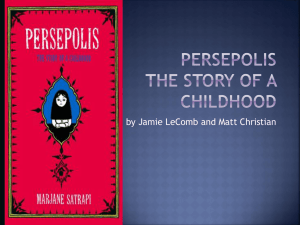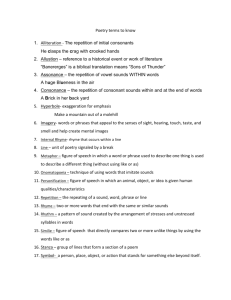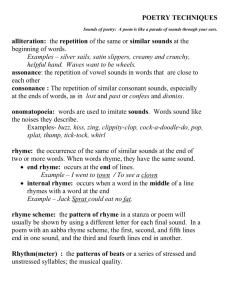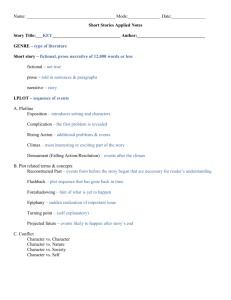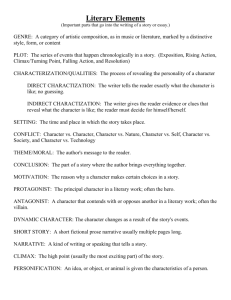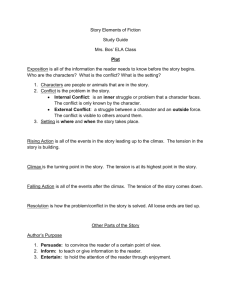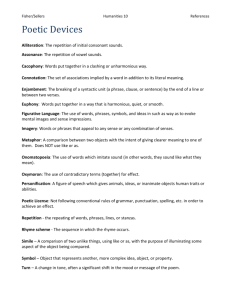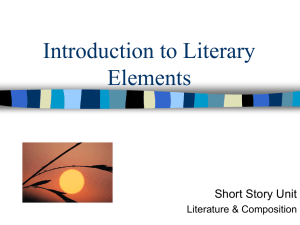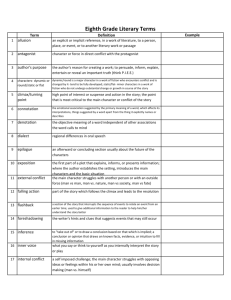Drama lit terms
advertisement
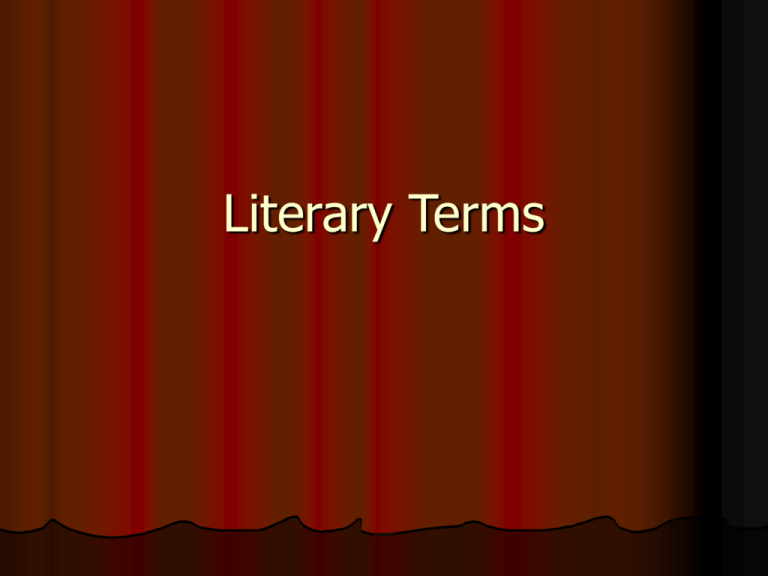
Literary Terms Prologue An introduction most frequently associated with drama. Prologues were frequently written by the author of a play and delivered by one of the chief actors Chorus Often recited by a single actor Foreshadows & comments on future/past events Background information Pun Or Word play that suggests two or more meanings for the same word Homonyms/homophones are commonly used as puns A figure of speech demonstrating a deliberate confusion of similar words or phrases for rhetorical effect Examples: There was once a cross-eyed teacher who couldn’t control his pupils. Police were called to a day-care where a three-year-old was resisting a rest. I couldn’t quite remember how to throw a boomerang, but eventually it came back to me. When the boss sold the carnival, he said it was a fair deal. “A trade sire, which is… indeed… a mender of bad soles.” Stage Directions Material that an author adds to a text to indicate movement, attitude, manner, style, or quality of speech, character, or action Genre type/category of literary works based on form, technique or subject matter. Drama the realistic portrayal of serious events; a story told in action by actors who impersonate the characters. (play) Comedy a lighter, with humor, form of drama that aims primarily to amuse (tells anecdotes/stories), and usually is marked by a happy ending. (marriages) Tragedy a type of play that ends/results in an unfavorable and unhappy ending/catastrophe and is treated with seriousness and dignity A play about a character’s downfall Main character(s) may end up dead or defeated Catastrophe/suffering awaits many of the characters, especially the hero Connotation vs. Denotation Connotation: the emotional association of a word (negative or positive) Denotation: the definition/meaning of the word, without emotional associations Figurative not literal (i.e. metaphors) Tone attitude of the speaker/author towards the subject, characters, or audience Mood the emotion a text evokes in the reader Conflict interplay between two opposing forces. Two types: 1) internal- a struggle between two elements within one character Ex. man vs self (mental/emotional/psychological/spiritual) 2) external- a struggle between a character and an outside force Ex. man vs man man vs nature man vs society man vs. Fate Soliloquy An extended speech delivered while the speaker is alone, in order to inform the audience of what is passing in the character’s mind (his/her inner thoughts or what the speaker is thinking inwardly, with the audience as listeners) Monologue An extended speech delivered by a single speaker to listeners (another character or crowd) onstage, but the listeners do not speak Dialogue A conversation between two or more characters Often serves to advance the action, give the impression of naturalness, present the interplay of ideas and personalities among those conversing, and/or give relief from descriptive/expository passages Aside when an actor directly addresses the audience, or another character, but is not supposed to be heard by other actors onstage (usually shorter than a monologue/soliloquy) Dramatic Irony the words or acts of a character carry meaning unperceived by the character or other characters but are understood by the audience (the audience/reader knows something that some of the characters are blind to) Irony Portrays the difference between appearance & reality, expectation & result, or meaning & intention Verbal irony: words are used to convey the opposite of what is meant Situational irony: an action or event directly contradicts the expectations of the characters, the reader, or the audience Dramatic irony: a contradiction between what a character thinks and what the reader/audience knows to be true (when the reader/audience knows something that the character does not) Oxymoron a self-contradictory combination/pair of words Ex. jumbo shrimp Metaphor A comparison without the use of the words “like” or “as” Example: She is a rose. Simile A comparison using the word “like” or “as” Example: She is as beautiful as a rose. Personification An object/animal is given human qualities, such as human thoughts, feelings, attitudes, & characteristics/personalities From the Latin root “per” = through Example: The sun smiled down on us. Hyperbole Extreme exaggeration for effect (not to be taken literally) Example: I am so hungry, I could eat a cow! Apostrophe Someone (absent, dead, nonexistent/ imaginary, or unspecified), some abstract quality/idea, or some personified thing is addressed (spoken to) as though actually present Examples: “O, pardon me, thou bleeding piece of earth,” “Oh Sinner!” Allusion A reference to a historical or literary figure, text, event, object, work of art, etc. outside of the literary work Often well known (something the author assumes the reader is likely to be familiar with) It is up to the reader to make the connection Common allusions are to the Bible, Shakespeare, mythology, politics, or current events Elision Omitting a syllable or sound in a word to make it easier to say or pronounce or to ensure rhythm/maintain meter in poetry/create pleasant sounds From the Latin “elidere” = to strike out Usually runs two words together by the omission of the final or initial sounds Common uses: laboratory, temperature, vegetable Shortened syllable count for poetry: ‘tis (instead of it is) ‘twas (instead of it was) Slang: gonna, dunno Syncope Omitting letters within a word (the interior of a word) to omit sounds/syllables Examples: o’er=over, n’er=never Apocope Omitting the end of a word to make it easier to say Examples: abs=abdominal muscles, ad=advertisement, bio=biology, decaf=decaffeinated, demo=demonstrated, limo=limousine Prose From the Greek “prosa,” meaning straightforward Ordinary speech (not poetic) Paragraph form No formal meter/rhyme Verse Poetic Meter & rhyme Scansion A close, critical reading of a poem, examining the work for its meter & the relevance of its meter Meter Natural rhythm of a poem Syllabic pattern (arrangement of syllables in repeated patterns) Basic unit in the description of the underlying rhythm of a poem unit=metrical foot (measured by syllables, not words; a foot can consist of multiple words, & a word can consist of multiple feet) Blank Verse Shakespeare’s poetry in unrhymed iambic pentameter Same letters/end rhyme plays Iambic Pentameter A line of poetry that has 10 syllables (5 metric feet) 2 syllables = 1 foot Iamb = a metric foot with two syllables, first unstressed & second stressed (most natural form of rhythm in the English language, usually producing a subtle but stable verse) Paralepsis Emphasizing a point by seeming to skip over it, which brings what’s being omitted to the forefront of people’s consciousness Example: “Have patience, gentle friends, I must not read it. / It is not meet you know how Caesar loved you.” Eulogy A dignified, formal speech or writing that praises a person/thing that is typically deceased Metonymy Substitution of the name of an object closely associated with a word for the word itself Example: crown = monarchy Example: suits = FBI/CIA agents Example: force = police Synecdoche Using a part to represent the whole Examples: a new set of wheels, “lend me your ears,” mouths to feed, give me a hand A specific kind used to refer to a more general kind Examples: Kleenex, Coke A material used to refer to an object composed of that material Examples: plastic, pigskin, threads Theme The main idea/central concept/topic/message of a literary work Usually requires a subject & a predicate Example: “the vanity of human wishes” instead of “human wishes” Symbol Something that is itself & also represents something else (suggests another level of meaning) Characterization The process by which an author reveals information about a character; methods the author uses to develop the personality of a character; - what the narrator/other characters say/think about (or respond to) the character - what the character says/thinks - what the character does - what the character looks like Direct: often a sign of poor writing, telling (not showing, e.g. He was a dimwitted man.) Indirect: showing (not telling) often inferred through action Types of Characters Round=complex (not always the good guy), fully developed both physically & emotionally, usually the main character that develops over the course of the story Flat=one-dimensional, undeveloped, often unrealistic, lack complexity (not necessarily a sign of poor writing) Dynamic=round, continuously change & evolve, often grows significantly & learns to be a better person (but can go the other way) Static=can be round or flat, does not change, essentially remains the same over the course of the story Protagonist=the main character/hero, the character the reader is supposed to root for, can be more than one character Antagonist=character that is in opposition to & works against the protagonist, doesn’t have to be a person (e.g. setting or situation) Archetype An image, descriptive detail, plot pattern, situation, symbol, or character type that occurs frequently in literature, myth, religion, folklore, etc. Examples: the hero, the quest, the journey, the task, the fall, the flood, death & rebirth, the devil figure, he unfaithful wife, the scapegoat (death in public ceremony expiates community’s sin), the outcast (banished from social group for some crime), the temptress (sensuous & beautiful, attracts protagonist & brings about his downfall), the earth mother (symbol of fruition/abundance/fertility, offering spiritual/emotional nourishment), the Platonic ideal (spiritual ideal, source of inspiration, idealized by protagonist who has intellectual attachment to her), the sorrowing mother (loses children, intense grief), light-darkness (light=hope/renewal/spiritual illumination, darkness=unknown/ignorance/despair), water-desert (water=birth/rebirth/regeneration, desert=spiritual sterility), heaven-hell (skies & mountains=gods, bowels of earth=diabolical forces) Setting The location, time, social circumstances in which story takes place Often contributes to the mood of the story General setting: overall location & time period Immediate setting: particular time & place within a story (similar to scene) Foreshadowing The presentation of material in a text in such a way that later events are prepared for (prepares the reader for future action) Establishment of mood/atmosphere Appearance of objects/facts as clues The revelation of a fundamental character Onomatopoeia The use of a word that suggests its meaning (sounds like what it means) Examples: buzz, clang Motif A recurring image, word, object, phrase, or action that unifies the text Bildungsroman Coming of age story About growing up Literal Language Exact in meaning Not exaggerated Figurative Language Language that is not exact in meaning Not to be taken literally Means more than what it says on the surface Gives a feeling about a subject Makes meaning fresh/clearer Expresses complexity Extends meaning Captures physical or sensory effect Concrete Language Sensory words Objects/events available to the five senses Abstract Language Ideas Concepts Not physical Can’t be perceived via 5 senses Examples: war, love, freedom, success Detail Part of an effective description Breaks down elements of description to elaborate on each part Juxtaposition The placing of two things close together or side by side for the sake of comparison/contrast Point of View The related experience of the narrator (not the author!) Texts often encourage the reader to identify with the narrator, not the author Can occur in 1st, 2nd, or 3rd person 1st person: narrator is a character that is part of the story, & narrative is limited by what the narrator knows/experiences/infers/discovers, used frequently, sacrifices omniscience for greater intimacy with one character, uses “I”/”We,” narrator can be the protagonist or someone close to the protagonist who is privy to the protagonist’s thoughts/actions or an ancillary character who has little to do with the action of the stpry 2nd person: main character is referred to with 2nd person personal pronouns (such as “you”), rare, difficult to take seriously, usually paired with present tense 3rd person: narrator is outside the action Omniscient: narrator is all-knowing, knows everything that needs to be known including all characters’ thoughts/feelings/motives Limited: narrator stays within the confines of what one knows/sees (only a part of the whole story), reader only gets the narrator’s biased perspective 3rd person omniscient: most common prior to 20th century 3rd person limited: most common during 20th & 21st centuries Paradox A statement/idea that appears false/contradictory/absurd but actually is true Imagery Descriptive language that evokes a sensory experience (sight, smell, taste, touch, sound); visual is most common Visual imagery = sight is most common (Example: The crimson liquid spilled from the container and onto the white page.) Auditory imagery = sound (Example: The bells chimed.) Olfactory imagery = smell (Example: His socks, still soaked with sweat from Tuesday’s P.E. class, filled the classroom with an aroma akin to salty, rotting fish.) Gustatory imagery = taste (Example: When I was swimming in the ocean, I accidentally took a gulp of briny, bitter liquid, causing me to cough and gag.) Tactile imagery = touch (Example: The soft play-dough oozed between Connor’s fingers.) Catharsis Emotional relief/purification/purging /clarification that an audience was supposed to experience upon viewing a Greek tragedy In drama, refers to a sudden emotional climax that evokes overwhelming sorrow, pity, laughter, or any other extreme change in emotion, resulting in restoration, renewal, and revitalization in audience members Cacophony A combination of harsh & unpleasant sounds Often caused by consonance Used in both poetry & prose to convey angry/discordant tone/feeling Euphony A combination of pleasant sounds Often created through assonance Used in both poetry & prose Common in love poems or pieces that want to convey soft & pleasant feelings Alliteration Repetition of initial consonant sounds or any vowel sounds in successive or closely associated syllables Example: “fiery flood of fierceness” Example: Peter Piper picked a peck of pickled peppers Example: killer cat Assonance Repetition of vowel sounds within successive or closely associated words Does not need to happen at the beginning of words Can create a soft fluency in sound and internal rhyme Example: “on a proud round cloud in a white high night” Consonance Repetition of consonant sounds within words, rather than at the beginning Example: All mammals named Pam are clammy. Anaphora Repetition of words/phrases/clauses at the beginning of successive or closely associated lines/sentences Common in speeches Used for emphasis Epistrophe/Antistrophe Repetition of words/phrases/clauses at the end of successive or closely associated lines/sentences Parallelism When several elements of equal importance are expressed in a sentence The same pattern of words show two or more clauses/ideas have the same level of importance; the repetition of words/grammatical structures/phrases, etc. Parallel sentence constructions Inversion/Anastrophe Words placed out of normal English order, often to accommodate the metrical pattern & maintain the regular meter/rhythm/rhyme; the placing of sentence elements out of their normal positions Think Yoda! Example: “Worried, I am. Afraid, is he.” Rhetorical Question A question asked for effect Does not require a reply From the root “retro” = backwards End Rhyme Rhyming words at the end of lines Example: been & sin Internal Rhyme Rhyme occurs at some place before the last syllable in a line Example: Here I am, an old man in a dry… Slant/Half Rhyme Near rhyme Partial rhyme Imperfect rhyme Examples: Dry & died, devil & evil, grown & moon Plot: sequence of events in a text Exposition Part of the work that introduces the characters, setting, events, basic situation, background information, etc. The “set up” Provides clarity for future plot Usually best when done indirectly Inciting Action The introduction of the central conflict Lets readers know what the protagonist is up against Hints at circumstances of climax Development/Rising Action Development: conflict increases Rising action: events that lead up to the climax, complication of the action, begins with exciting force (which starts the conflict), gains interest & power as oppositions come into conflict, proceeds to climax Events that push the story forward Adds tension to the plot Climax The height of suspense/interest Turning point Point at which conflict reaches its highest point The “big battle” (can be external or internal) Falling Action Events after the climax that lead to the resolution Not always necessary/apparent Resolution The end of the central conflict/tension May tie up loose ends Not always happy Denouement Any events that occur after the resolution May tie up loose ends Not always happy Diction Word choice Formal diction: elevated & dignified, often complex & impersonal, follows grammar rules Middle diction: maintains correct language but less elevated, reflects how most educated people speak Informal Diction: plain language of everyday use, includes slang, idioms, & common words Syntax Sentence structure; arrangement of words Even with formal diction, a lack of variety or overly simplistic syntax can lower the level of language in an essay (compound, complex sentences vs. short, choppy sentences) Stoicism Philosophical belief began 3rd century B.C. by founder Zeno & lasted for 500 years Belief in self-control, little expression of emotion, & a denial of passion From Greek for "painted portico" in Athens where the group met and talked Zeno: one's duty was to behave in a rational & calm manner and not let emotion cloud thinking Acceptance of what happened as part of the law of nature. Seems bleak & rigid today but popular in Greece During the Roman Empire, emphasis on social duty, the importance of the law, & equal rights for all Brutus Epicureanism Epicurus=Greek philosopher who lived from 341 B.C. to 270 B.C.; believed life best understood by awareness of sensory perceptions Belief that the most important goal was to seek pleasure & avoid pain. Did not believe in fearing gods because there was no life after death Epicurus didn’t acknowledge power of supernatural omens, dreams, & other portents so would not have assigned much importance to Calpurnia's dream Influenced modern hedonism (some same tenets) Ecphonesis Emotional, exclamatory phrase; call out/express sudden emotion In drama, poetry, song Rhetorical device in ancient literature Greek in origin “O” often used but not necessary - To Renaissance audience, “O” literally meant one’s heart was bleeding - “O” sounds = distraught emotional state & serious health concern Examples: “O, the times!” Anadiplosis “Doubling back” Repetition of last word of a preceding clause Word used at end of sentence & used again at beginning of next sentence Example: “Fear leads to anger. Anger leads to hate. Hate leads to suffering.” Asyndeton From the Greek “unconnected” Deliberate omission of conjunctions from a series of related clauses Speeds up the rhythm to make more memorable Examples: “I came, I saw, I conquered.” “government of the people, by the people, for the people” “Friends, Romans, Countrymen” Chiasmus “to shape like the letter x” Two or more clauses are related to each other through a reversal of structures in order to make a larger point Criss-cross structure Inverted parallelism Popular in Greek & Roman texts Example: “He knowingly led, and we followed blindly.” A B A B subject, adverb, verb, conjunction (cross) subject, verb, adverb Antithesis From Greek for “setting opposition” A counter proposition Denotes a direct contrast to the original proposition Setting the opposite brings out a contrast in meaning by obvious contrast in expression Examples: “Many are called, but few are chosen.” “Give every man thy ear but few thy voice.” “Man proposes, God disposes.” In literary fiction, can describe a character who presents the exact opposite (personality type/moral outlook) to another character, e.g. Voldemort & Dumbledore
